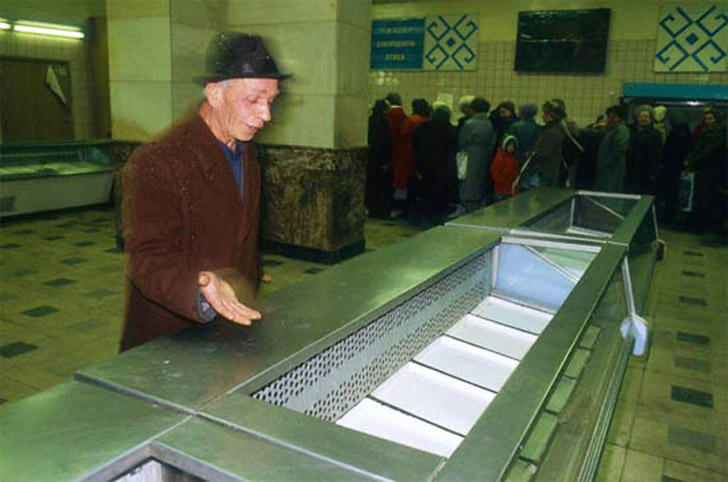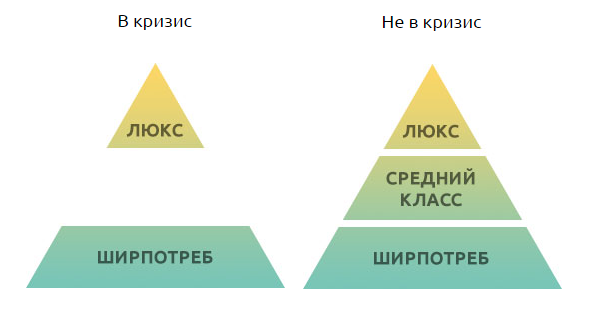How to sell more through examination: video and text tips

In a crisis, the market looks like this. If you look right in front of you.
So, 2015 has come, CFOs and CEOs have tidy up the remaining funds in the company under their wing - and are in no hurry to part with them.
What to do?
Do not sell anything!
If you think about it, this is a working approach: you are not just selling a solution - you are selling your expertise packaged in a product.
And the expert works not only with the client’s material, he has his own experience, that is, he can offer the client something customized.
Or consciously push the client out of the comfort zone. For example, to offer a new niche: because not all industries will conduct and feel as before.
And finally, an expert can offer an alternative: up to “go to a competitor, he has this and that and not that”. It also shows the price tag against the rest of the market, and if necessary demonstrates that it is not afraid to lose a customer (while leaving the comfort of the purchase).
Because, as a maximum, the client will return to you, but at least - you will not torment yourself with him in the future. Knowing the strengths and weaknesses of your competitors for the client is also a plus. And it will help you to think less about those competitors - now it’s not up to them.
That is, you really do not sell anything. Nothing out of the ordinary.
But at the same time, your main slogan at this time is: "We will increase your sales." Provided that you are really ready to give a result.
Why is that?
In unstable times, the market collapses. That is, literally, if you look directly in front of you, you are likely to see nothing. Because the middle segment is washed out, as always.

The greatest chances are those whose services are knocked out: either due to quality, or due to price. If you feel in the middle segment, it's time to “drift”.
At the same time, there will remain those who buy not where it is better, but where there is a higher discount (not the price - you understand the difference). Such can be up to 50%.
What does not work
Approaches like “let's try, but we'll see, eh?” Or “tomorrow is more expensive” . Such are put off in a long box - and you need to come to terms with this.
Approaches “you wanted a fresh idea - here” . Because you still need a ready-made (and already customized at the offer level) solution.
The themes of “getting a budget from good old customers” also remained in the past.
Even “but let's cut costs” is not the best option. Unless at times and not in profile actions.
And the result - and the expertise that you vouch for, are your value proposition. And often the client’s question is precisely this. In value.
Therefore, to begin communication with the client now you need to immediately with the benefits.
You can even compare the lack of a solution with the presence of a solution by the client - this is an interesting approach.
Step one. Crush communication
If you try to explain to a person the structure of the entire Universe right away, he will probably go crazy. Or, rather, turn away. The forms of satiety with information, its volume and reaction to “overdose” and incorrect delivery (the same call to action for further action) are still poorly understood.
But it’s clear: a service is a solution - a project = / = is not a transaction yet.
That is why it is much easier to split communication for the next target step, and not for sale right away.
Here are at least two verification criteria:
1) What goal are we achieving right now?
2) What should “that side” do in response?
If this is the first letter, then:
- Pay attention to the structure - consider all the important details that will affect the decision to continue communication.
- Clearly describe the problem, clearly describe the solution, offer a reasoned next step (this is not always a meeting right away).
- Carefully segment recipients!
Here is a typical example, we ourselves have sinned with such:
And here is a good example that we made with an expert:
Step Two 5 second presentation
It is important that the words “send me your commercial” do not break off.
It is clear that the market is such that someone needs the fullness of information, while someone needs less. Therefore - customize the approach.
And the rest - remember that a person can withstand a slide for 5 seconds of reading, so you can split up heavy information here too - after all, slides are shareware for you.
At this step, it is also important to check the sales logic again . As you know, you need to sell "not a broom, but a clean floor."
Below we have collected video examples of a couple of project errors. Disclaimer: often in the presentation include information relevant to several groups at once; as a result, it is not interesting for anyone to read it.
- how to lose and not lose conversion
- how to sell a complete solution, not pieces:
What's next?
Mail, as the first filter, was most effective. It immediately shows whether a person understands what he came with. Or not.
If you have passed it, you can schedule an appointment (but, again, keep in mind a clear plan and specific goals, be able to convey them to that side).
We hope this topic will help increase your sales.
And if the above is not enough, welcome here .
PS
In this post we did not consider:
- real scripts from companies that do not have problems with leads,
- the practice of working with a sales funnel and aspects relevant for b2c projects that need partnerships with businesses,
- how to work with a client who is not ready to buy,
- how to choose the lead generation system that suits your case,
- and which approaches are better to use instead of cold calls.
These are the topics that #tceh will cover after the next master class by Leonid Val , an expert who also helped us.
We are ready to invite 1 person for free. How to get to this place?
- state in the comments what your expertise is, plus tell us what bottleneck is preventing you from growing sales.
- Wait 19 hours on March 3. Leonid and our team will look at your cases - and if we understand that we can help, we will certainly help - we invite you to participate in the seminar for free.
All other commentators will receive a 15 percent discount on participation (with a progressive price it’s relevant).
Comments are accepted until 11 a.m. on March 3.
